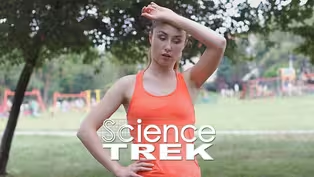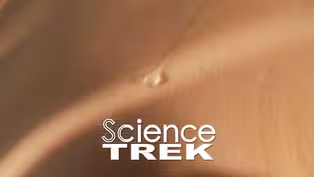
Skin: Animal Skin
Special | 7m 20sVideo has Closed Captions
Animal skin can have superhero like properties.
Humans aren’t the only creatures with skin. Mammals, amphibians and birds have skin too. Animal skin does much of what human skin does, but some animal skins have amazing properties. Join us on a tour of animal skin at ZooBoise.
Problems playing video? | Closed Captioning Feedback
Problems playing video? | Closed Captioning Feedback
Science Trek is a local public television program presented by IdahoPTV
Major Funding by the Laura Moore Cunningham Foundation and the Idaho National Laboratory. Additional Funding by Sparklight, the Friends of Idaho Public Television and the Corporation for Public Broadcasting.

Skin: Animal Skin
Special | 7m 20sVideo has Closed Captions
Humans aren’t the only creatures with skin. Mammals, amphibians and birds have skin too. Animal skin does much of what human skin does, but some animal skins have amazing properties. Join us on a tour of animal skin at ZooBoise.
Problems playing video? | Closed Captioning Feedback
How to Watch Science Trek
Science Trek is available to stream on pbs.org and the free PBS App, available on iPhone, Apple TV, Android TV, Android smartphones, Amazon Fire TV, Amazon Fire Tablet, Roku, Samsung Smart TV, and Vizio.

Science Trek
Science Trek is a place where parents, kids, and educators can watch short, educational videos on a variety of science topics. Every Monday Science Trek releases a new video that introduces children to math, science, technology, engineering, and math (STEM) career potentials in a fun, informative way.Part of These Collections

Animals
Animals play an important role in the Earth’s ecosystems. Find out more about animals.
View Collection
Human Body
How does your body work? Find out more about the systems that combine to make up you.
View CollectionProviding Support for PBS.org
Learn Moreabout PBS online sponsorshipJoan Cartan-Hansen, Host: Humans aren't the only ones with skin.
Mammals, fish, birds and amphibians have skin too.
But some animals' skin has special properties that human skin doesn't.
[MUSIC] Cartan-Hansen: Harry Peachey is the curator at Zoo Boise.
If you ask him which animals have unusual skin, he'll start with the lions.
Harry Peachey, Curator, Zoo Boise: The skin there plays a role, an important role in combat, when lions interacting with one another, they sometimes interact aggressively.
That skin is very, very thick and it's designed to withstand those blows that come from other lions.
The hair on a lion's skin also plays a specialized role.
I think we all recognize that male lions have a very thick mane.
It's not really that involved in maintaining a proper body temperature or protecting from heat or cold, but it does protect from other lions.
Female lions also have a mane, but it's the same color as the rest of the hair on their skin, and it usually is not very thick.
But if you look closely at a female lion, sometimes you will see that mane.
Zebra skin is one of those skins that I think everybody recognizes.
I think everybody has probably asked the question at some point, is a zebra black with white stripes, or is it white with black stripes?
The typical answer is the zebras are white with black stripes.
The reason that people have settled on that answer is because if you look at a zebra and you look in particular at the belly on most of the different species of zebras that is all white.
The stripes actually serve a couple of different functions, in general its part of camouflage.
And if you see zebras, typically zebras are running in a group with other zebras.
If a predator comes along and wants to, to catch a zebra, those stripes make it very difficult for a predator to settle on an individual animal.
It also makes it hard for a predator to judge distance in daylight.
Uh, those stripes, the contrast between the black and the white will make it difficult for a lion, for example, to determine if a zebra is 70 feet away or 120 feet away.
fur of many mammals, reptiles have skin more like armor.
Peachey says one reptile's skin stands out.
Peachey: Crocodile skin actually is, is very unusual, and very specialized.
They have some unique features that you won't find in very many, if any, other species.
The skin obviously looks different.
You can see a lot of structure in the skin that is unique to crocodiles and alligators.
But the skin is able to do things like detect, magnetic impulses, uh, electrical impulses.
Cartan-Hansen: And unlike human skin which is generally smooth, crocodile and alligator skin is not.
Peachey: The bumps you see on the now crocodile skin are referred to as scutes.
And those are part of that, advanced, very specialized ability they have to detect changes in differences in their environment.
In addition to detecting things like the difference in saltwater and freshwater, they also are very sensitive to vibrations.
And also in this may be obvious to most people, a Nile crocodiles skin is waterproof.
It's an advantage for them as a living creature, but it's kind of a disadvantage in the long run because that attracted people to hunting alligators, capturing alligators and crocodiles and using their skinr shoes.
We are now by our Olive baboon habitat.
One of the things that you'll notice right away about baboons' skin is that bare area that has no hair.
It's a callus.
It's referred to as a callosite and that's a very thick patch of skin.
There are no nerve endings there, so they don't feel things with that.
This actually serves a couple of purposes.
One is, if you look at the baboons in the exhibit here, you'll see that they might be sitting on a wide variety of different surfaces, which if they didn't have this callosite would be very uncomfortable.
But the other thing it does is it serves as a communication aid.
So, a female baboon, for example, can communicate her willingness to interact with a male by the color of those callous sites.
When they turn pink or even red, that's an indication to a male that that's a female that might be ready to reproduce.
Cartan-Hansen: Our last stop on this animal skin tour is at the Southern Ground Hornbill.
Peachey: When you think of birds, you think of feathers before you think of skin, but, uh, there is a feature that's very obvious on a Southern Ground Hornbill that is made up of skin.
And that is that red patch on the throat that goes up on the side of the head.
That bag, if you will, on their throat is referred to as a wattle.
And it's involved in communication.
They use that to produce and amplify sound.
That red skin on their face that is attached to that wattle, kind of an extension of that skin, is actually an adaptation that helps with the Southern Ground Hornbills when they are feeding and hunting.
As the name implies, they spend a lot of the time on the ground.
They will dig for insects.
So, they take that long beak and they will Peck on the ground.
And that throws up not only insects, but bits of dust and dirt, that skin around the eye, it projects a little bit, it reduces the amount of dirt that might accidentally end up in their eyes.
Cartan-Hansen: Animals instinctively know to care for their skin.
Some get clean.
Some get dirty.
Some just chill in the shade.
Zoos like Zoo Boise even design their animal environments with skin care in mind.
Pools, landscaping.even special ramps, like this one for the crocodile, are all to help animals stay happy and alive.
Peachey: Since we all have skin, sometimes we'll take it for granted, but it's important to realize that without skin we would not survive a number of the things that our body has to do in order to keep us healthy are dependent on the presence of not just skin but healthy skin.
Cartan-Hansen: If you want to learn more about skin, check out the science trek website.
You'll find it at science trek dot org.
[MUSIC] ANNOUNCER: Presentation of Science Trek on Idaho Public Television is made possible through the generous support of the Laura Moore Cunningham Foundation, committed to fulfilling the Moore and Bettis family legacy of building the great state of Idaho.
By the Idaho National Laboratory, mentoring talent and finding solutions for energy and security challenges, by The Friends of Idaho Public Television and by the Corporation for Public Broadcasting.
Video has Closed Captions
Clip: Special | 1m 4s | Which nerves do what in your body? (1m 4s)
Video has Closed Captions
Clip: Special | 1m 4s | What is living on your skin? (1m 4s)
Providing Support for PBS.org
Learn Moreabout PBS online sponsorship
- Science and Nature

Explore scientific discoveries on television's most acclaimed science documentary series.

- Science and Nature

Capturing the splendor of the natural world, from the African plains to the Antarctic ice.












Support for PBS provided by:
Science Trek is a local public television program presented by IdahoPTV
Major Funding by the Laura Moore Cunningham Foundation and the Idaho National Laboratory. Additional Funding by Sparklight, the Friends of Idaho Public Television and the Corporation for Public Broadcasting.

